Sony ZV1 vs A7C review
-
-
Written by Gordon Laing
In this review I’ll be directly comparing the Sony ZV1 against the Sony A7C, two very different cameras but both aimed at a very similar audience. The ZV1 is a fixed-lens compact with a 24-70 equivalent zoom and a 1in sensor that costs 700 dollars or pounds. Meanwhile the A7C is an interchangeable lens camera with a full-frame sensor that costs around 2100 dollars or pounds with the 28-60 kit zoom.
In terms of sensor area, weight, size and price, they couldn’t be more different, and yet they’re both targeting similar people, in particular the needs of video creators with a number of overlapping features – including similar photo and video resolutions, side-hinged screens that can face-forward, microphone inputs and even similar zoom ranges out-of-the-box. So rather than review them separately, I thought I’d try out the exact same tasks with each camera side-by-side to see how they directly compare, and while some results will play out as expected, others may surprise you. All of my tests and comparisons are in the video below, but I’ve also pulled-out some written highlights lower down for those who prefer that format!
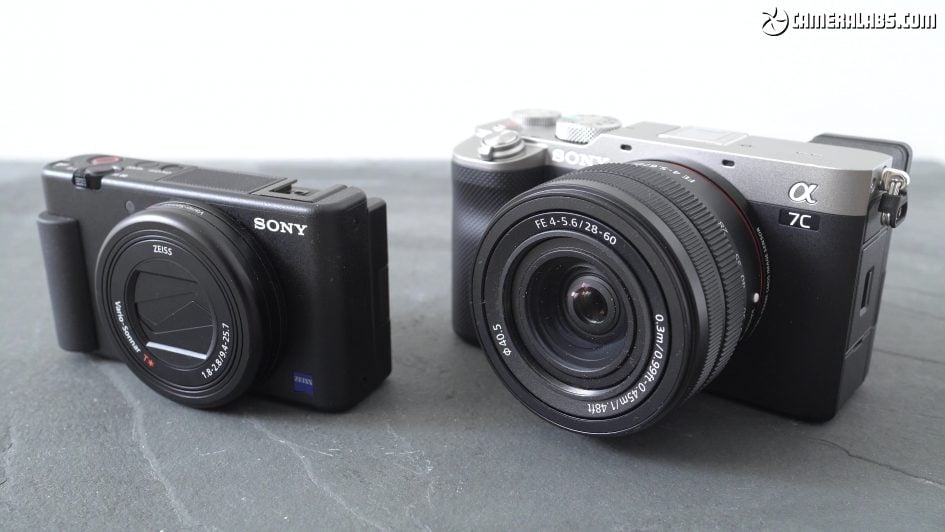
Above: Both the ZV1 and A7C are strongly based on earlier models: the ZV1 shares the same sensor, lens and much the same photo and video quality as the RX100 V and VA, while the A7C shares the same sensor and similar photo and video quality to the A7 III. Both new models sport improved colour profiles and updated autofocus, but since the core photo and video quality is so similar to older models I’m not going to repeat what I’ve already published in my original reviews of those cameras – so check them out if you need more details. Instead in this review I’ll concentrate on what makes them different from their predecessors, which is mostly about an improved video experience, and how they directly compare against each other.
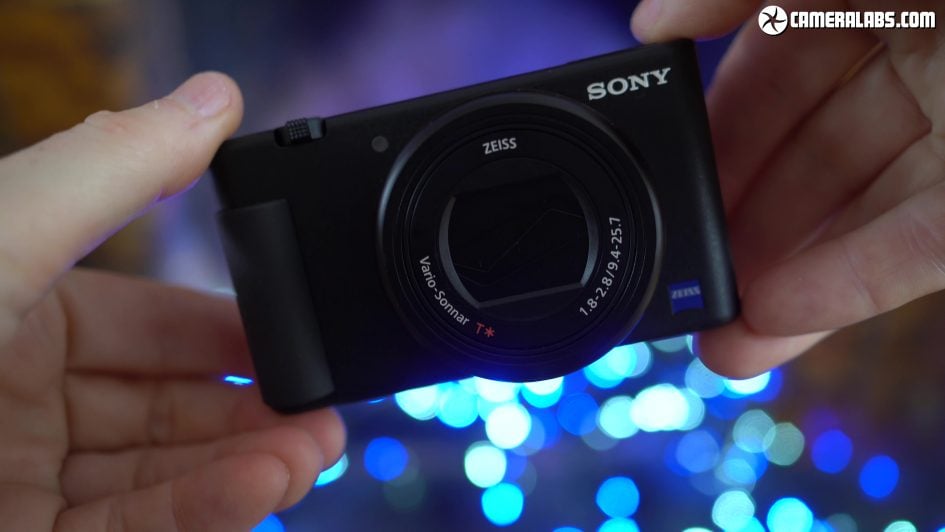
Above: Now let’s start with the physical tour. The ZV1 is a compact camera measuring 106x60x44mm allowing it to squeeze into larger pockets, something the A7C can only dream of, while you’ll barely notice the 294g weight including battery. The ZV1 inherits the 24-70 f1.8-2.8 zoom from the RX100 VA, which means you also get a built-in three-stop ND filter along with an automatic sliding cover, so no lens caps to worry about – both handy benefits over the A7C and it’ll also focus as close as 5cm, but unlike the A7C you can’t swap lenses.
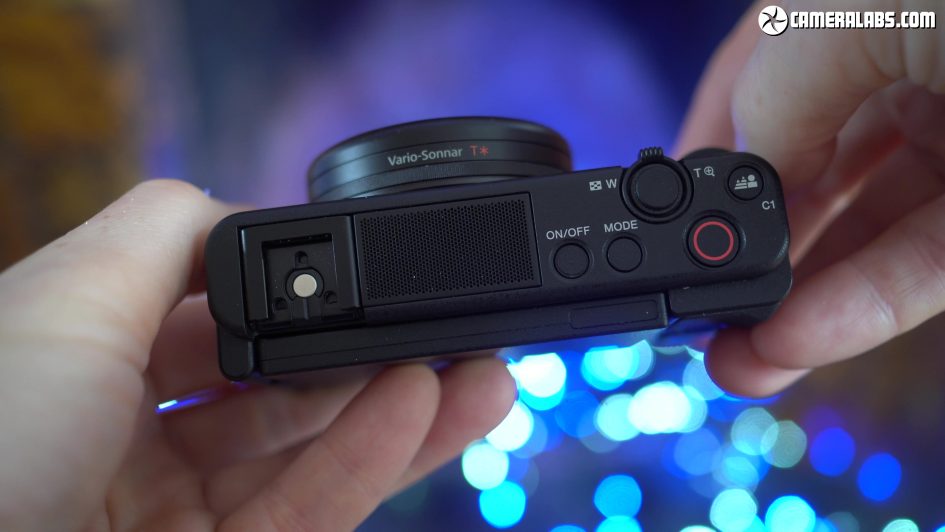
Above: The top surface is different from recent RX100 models, reinstating a hotshoe and now featuring a three-capsule mic and a generously sized record button. You can mount accessories on the hotshoe without blocking the screen and Sony includes a handy wind-muffler giving it an advantage over the A7C. In the biggest departure from the RX100 series, the screen is now side-hinged, allowing it to flip-out and twist round to face you without any hotshoe accessories getting in the way. The hotshoe does however mean the popup viewfinder of recent RX100 models has been sacrificed, so composition, playback and menus are with the screen only. You can also set the ZV1 to use the screen as a power switch, turning the camera on when you flip the screen out and turning it off again as you fold it back. Oh and in a nice update over the RX100 and A7 series the ZV1 also sports a tally lamp on the front which can indicate when you’re recording.
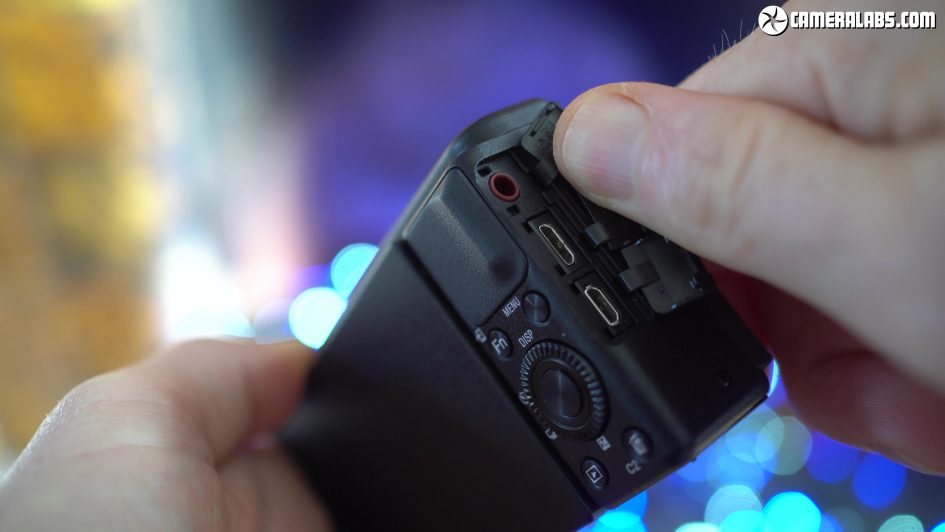
Above: In terms of ports, the ZV1 is equipped with Micro HDMI, Micro USB and a 3.5mm microphone input which is also sufficiently high to clear the screen. Unlike the A7C though, there’s no headphone jack and the USB port is the older Micro type.
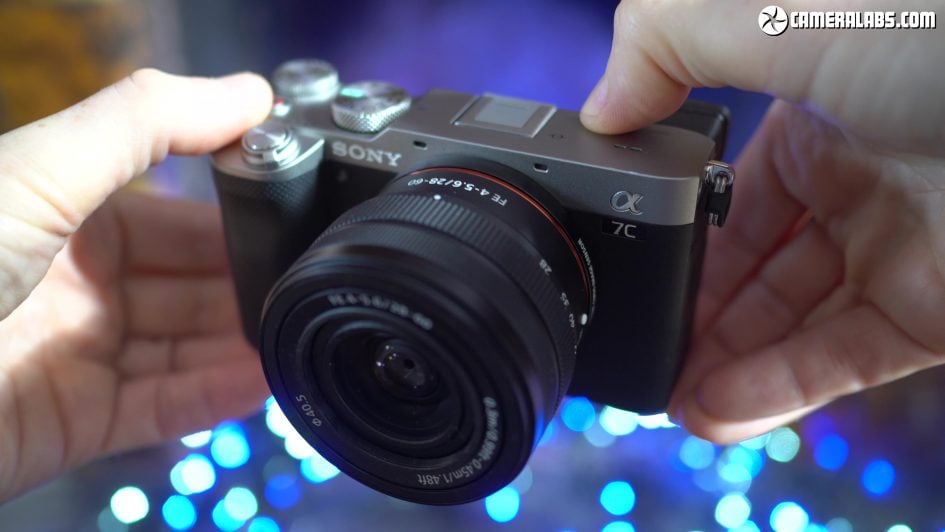
Above: Moving on, here’s the A7C which at 124x71x60mm may be one of the smallest full-frame cameras around, but it’s considerably larger than the ZV1, and at 676g including the kit zoom, more than double the weight too – although to be fair it’s lighter than the A7 III and easier to accommodate on smaller gimbals than that model. The A7C’s grip is also larger than the ZV1 and the body’s weather-sealed too. From above you can get a better look at the new FE 28-60mm f4-5.6 kit lens, although as a retractable design, you will need to twist the zoom ring to the 28 position before you can use it – that said, you also need to wait for the ZV1 lens to extend during power-up. The focusing on the 28-60 isn’t anywhere near as close though with a 30cm minimum.
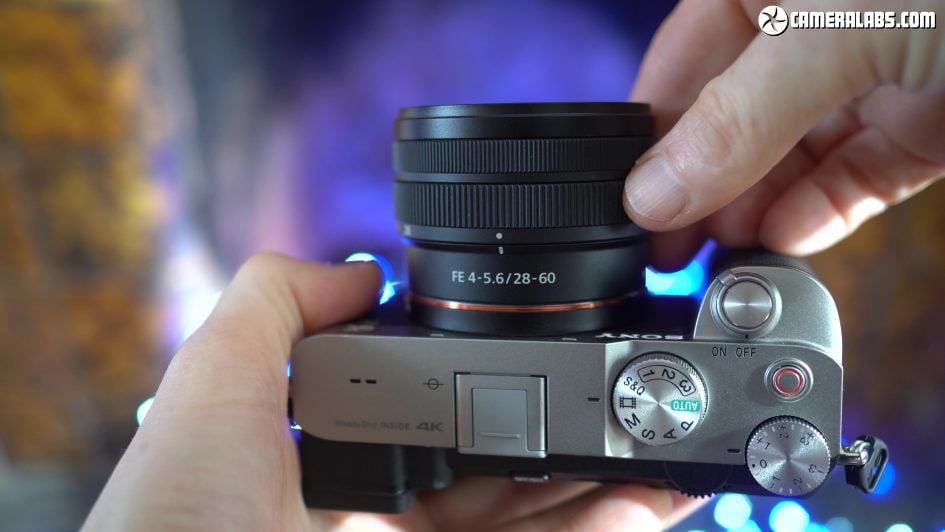
Above: Meanwhile the top panel departs from the central viewfinder hump of earlier A7 models for a flatter rangefinder style. Note the dedicated record button on top, smaller than the ZV1’s, but still easier to use than the A7 III’s awkward corner button. The hotshoe also now supports a digital connection to the ECM-B1M digital mic. From the rear the rangefinder styling continues with the viewfinder relocated from the A7 III’s central hump to the top left corner – the EVF resolution may be the same as the A7 III but the image is much smaller and the housing less comfortable to use. It may be a downgrade from the A7 III to reduce size, but still remains a useful feature that’s absent on the ZV1. Like the ZV1 though, the side-hinged screen can now flip-out and twist to any angle, including facing forward which is a major benefit over the A7 III for many video creators. Unlike the ZV1, the screen flip won’t power the camera on and off, and there’s also no tally lamp on the front to indicate recording. Oh and in terms of controls, the A7C may have more than ZV1 but lacks the front finger dial and rear joystick of the A7 III, and has fewer custom buttons too.
In terms of ports, the A7C has a 3.5mm microphone input positioned, like the ZV1 to clear the screen, and you’ll want to use an external mic if you’re walking with the camera as the strap lugs rattle quite audibly. The A7C also has a Micro HDMI, but a more modern USB-C port, as well as the useful inclusion of a headphone jack that’s missing on the ZV1. Also note the SD memory card slot has relocated to this side of the camera, although more importantly it’s been downgraded from the dual slots of the A7 III. So while the A7C gains a side-hinged screen over the A7III, it loses out on the dual card slots, joystick, finger dial and bigger viewfinder, as well as that camera’s second USB port and faster 1/8000 maximum shutter. Bottom line is while the photo and video quality on both models is very similar, the A7 III will be preferred for people who shoot mostly photos, while the A7C preferred for those who shoot mostly video.
Moving onto power, the ZV1 and A7C use very different batteries, and the A7C’s larger body of course allows it to accommodate a much larger pack. In photo terms you’re looking at two to three times more shots per charge from the A7C, although both cameras can at least be charged or powered over USB if you get caught short. For video, I set both cameras recording 4k 25p at the same time with the high temp warning disabled on both models. The ZV1 managed 65 minutes on a single charge, and in a single clip too, a big upgrade over the RX100 V. Meanwhile the A7C kept recording for just shy of three hours, again in a single clip, making it more suitable for recording long uninterrupted events or interviews – it’s also a key advantage over the A7 III which limits you to half hour clips. Coincidentally with their standard lenses, both cameras shared similar focusing in low light, with the brighter lens on the ZV1 compensating for its smaller sensor. You’ll see more examples of bright lens and small sensor vs dim lens and large sensor in my video above.
Sony ZV1 vs A7C verdict
If you’re deciding between the ZV1 / A7C and their predecessors, I’d say the decision is based on whether you shoot mostly photos or mostly shoot video. Both the new and older models are perfectly good at capturing photos and video, but if you mostly shoot photos, I’d prefer the feature-sets of the older A7 III or RX100 series over the A7C or ZV1 respectively. Conversely if you mostly shoot video, I’d go for the A7C over the A7 III and the ZV1 over the RX100 for all the benefits I’ve pointed out during this review. The tougher question though is whether to go for the ZV1 or A7C if you’re a video creator.
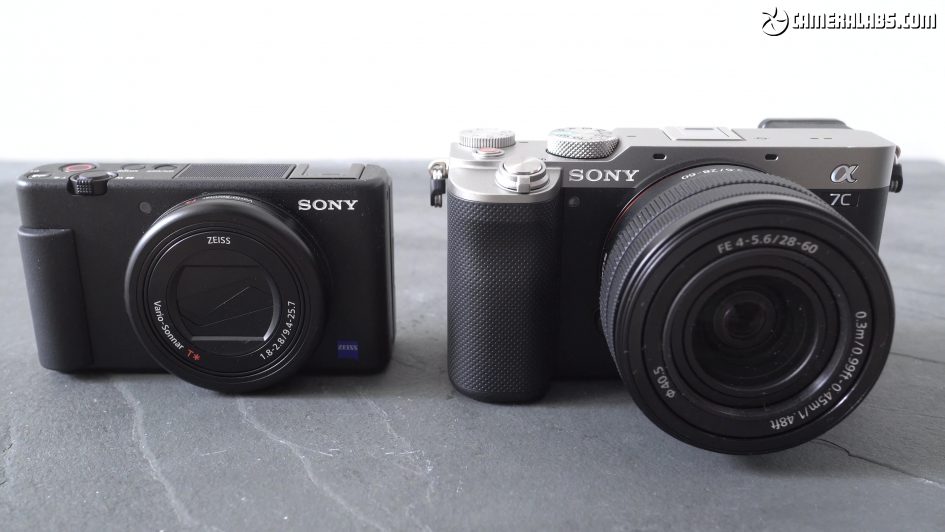
Irrespective of price from my own tests I’d actually say the ZV1 is preferable for video creators out of the box. Most obviously its lens is more flexible and convenient with a broader range, built-in ND filter, automatic lens cover and much closer focusing, while its bright aperture compensates for the smaller sensor behind it in terms of ISO and depth-of-field. The built-in microphone also proved more practical in my tests, with the supplied wind muffler and no rattling strap lugs to worry about. Beyond this, the ZV1 also includes a useful tally lamp and a bunch of software enhancements that make it easier and more natural to film with, most notably the simple but brilliant product showcase mode that can single-handedly transform product review videos. The ZV1 could have been perfect with a wider lens to make digital stabilisation more practical, but as it stands, it’s still an excellent choice for the money.
That said, the A7C certainly has worthwhile benefits over the ZV1. It includes a viewfinder that while small, remains invaluable for checking footage and menus, especially for those with long-sight. It provides a headphone jack, much longer battery life, a digital interface to Sony’s optional microphone, and most importantly the huge potential of a much larger sensor and the chance to swap lenses.
The full-frame sensor and lens mount are what you’re paying for here, but if you’re using the kit zoom with the A7C, this core benefit becomes moot. I commend Sony for creating a truly compact lens to complement the camera, but the FE 28-60 is simply unsuitable for a lot of the target audience. 28mm is nowhere near wide enough for handheld vlogging, especially if you’re using Catalyst to apply stabilisation; the minimum focusing distance makes it impractical for product closeups, and the modest aperture means much of the bigger sensor’s benefit is effectively cancelled-out. Indeed I was struck by how similar the output from the ZV1 looked to the A7C and kit zoom under the same conditions.
It’s also revealing to compare the different strategies of recent full-framers aimed at video creators. Panasonic’s Lumix S 20-60mm – the kit zoom for the S5 – may be a larger and heavier lens, but zooms much wider and focuses closer too, making it much more practical overall.
To really enjoy the potential of the A7C you’ll simply need to fit it with a different lens straightaway, whether to deliver wider coverage, closer focusing or shallower depth-of-field effects – like the FE 16-35mm f2.8 seen here, stabilised in Catalyst. But you also have to ask yourself if you’re over-thinking the problem.
If all you want is a wide view and crazy stabilisation, how about the GoPro Hero 9? Yes it’s over-sharpened by default and yes, everything is in focus, but just look at the stabilisation out of camera with no post-processing, and there’s a Boost mode that’s even better. And if you prefer less extreme coverage, its Linear mode crops-in for a more natural view. And at 350 dollars or pounds, it’s much cheaper – in fact less than half that of the ZV1. The tiny sensor in the GoPro means the picture quickly falls apart in low light – even the mall vlog here looks softer than the Sonys – but for me the Hero 9 remains the best choice if you’re filming yourself walking and talking in bright conditions. You should also consider the DJI Osmo Pocket.
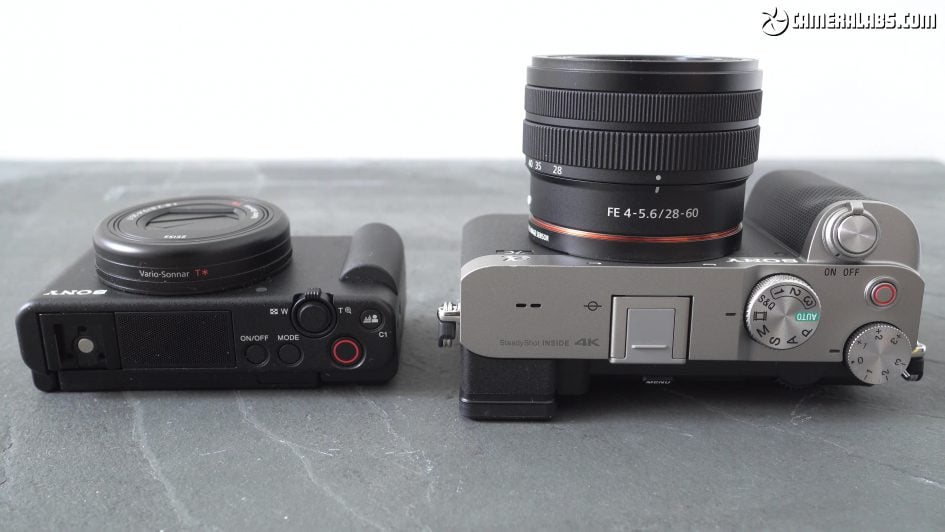
Ultimately my overall opinion of the A7C may have been more positive had it been bundled with a different lens, and of course there’s nothing stopping you from doing this yourself. The bottom line is the FE 28-60 may be ok for general use, but many video creators will find it frustrating and want to switch it for something more capable as soon as possible.
Meanwhile the surprise winner in this comparison is the ZV1. I was already very fond of the RX100 series and while the ZV1 loses the useful viewfinder, it gains a side-hinged forward facing touchscreen, a hotshoe for accessories, an improved microphone with windshield, the cunning product showcase mode, gyro data for post-stabilisation and the ability to record clips beyond half an hour. For all-round video creators filming in a wide variety of conditions, it’s one of the best overall solutions available and it comes in well-under four figures.
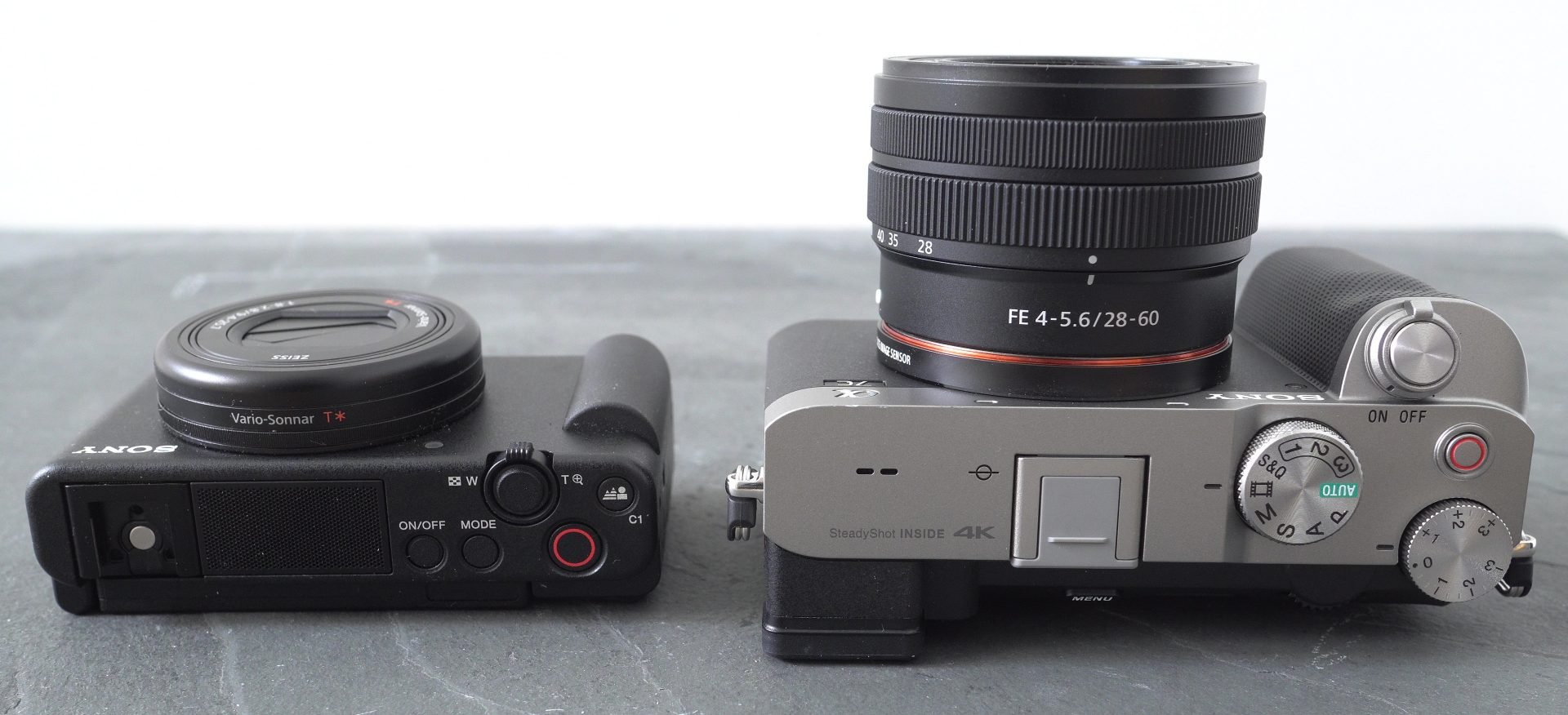
 Irrespective of price from my own tests I’d say the ZV1 is preferable for video creators out of the box. Most obviously its built-in lens is more flexible and convenient than the A7C’s 28-60 kit zoom, with a broader range, built-in ND filter, automatic lens cover and much closer focusing, while its bright aperture compensates for the smaller sensor behind it in terms of ISO and depth-of-field. The built-in microphone also proved more practical in my tests, with the supplied wind muffler and no rattling strap lugs to worry about. Beyond this, the ZV1 also includes a useful tally lamp and a bunch of software enhancements that make it easier and more natural to film with, most notably the simple but brilliant product showcase mode that can single-handedly transform product review videos. The ZV1 could have been perfect with a wider lens to make digital stabilisation more practical, but as it stands, it’s still an excellent choice for the money. That said, the A7C certainly has worthwhile benefits over the ZV1, including a small but useful viewfinder, headphone jack, much longer battery life, a digital interface to Sony’s optional microphone, and most importantly the huge potential of a much larger sensor and the chance to swap lenses. But many video creators will find the 28-60 kit zoom frustrating based on modest wide-angle coverage and its inability to focus close to products, so they’ll need to consider alternative lenses sooner rather than later.
Irrespective of price from my own tests I’d say the ZV1 is preferable for video creators out of the box. Most obviously its built-in lens is more flexible and convenient than the A7C’s 28-60 kit zoom, with a broader range, built-in ND filter, automatic lens cover and much closer focusing, while its bright aperture compensates for the smaller sensor behind it in terms of ISO and depth-of-field. The built-in microphone also proved more practical in my tests, with the supplied wind muffler and no rattling strap lugs to worry about. Beyond this, the ZV1 also includes a useful tally lamp and a bunch of software enhancements that make it easier and more natural to film with, most notably the simple but brilliant product showcase mode that can single-handedly transform product review videos. The ZV1 could have been perfect with a wider lens to make digital stabilisation more practical, but as it stands, it’s still an excellent choice for the money. That said, the A7C certainly has worthwhile benefits over the ZV1, including a small but useful viewfinder, headphone jack, much longer battery life, a digital interface to Sony’s optional microphone, and most importantly the huge potential of a much larger sensor and the chance to swap lenses. But many video creators will find the 28-60 kit zoom frustrating based on modest wide-angle coverage and its inability to focus close to products, so they’ll need to consider alternative lenses sooner rather than later.



